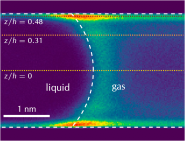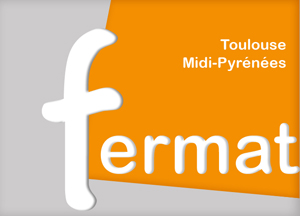COCLICO - Physics of the COntaCt Line: from physical chemistry to hydrOdynamics
Principal Investigators (PI)

T. Ondarçuhu, P. Tordjeman (IMFT) – C. Picard, B. Coasne (LIPhy)
COCLICO objectives

The physical description of wetting dynamics, which is ubiquitous in natural and industrial processes, is a well-known complex problem. In particular, the intrinsic coupling between physical chemistry and hydrodynamics around the contact line challenges existing framework remains a blind spot in the field. Hence, a better understanding of the molecular processes at the contact line and their impact on the macroscopic thermodynamics and dynamics of wetting could impulse a new momentum in the discipline. In particular, the identification of novel phenomena at the contact line would push forward modelling in the spirit of recent advances in nanofluidics in which hydrodynamics was found to combine with charge effects, physical chemistry and even quantum chemistry).
Using a nano-to-macro approach combining experiment, molecular simulation and theory, the COCLICO project will consider diphasic (gas + liquid) systems (see Figure) to address fundamental questions associated to the chemical structure, thermodynamics and dynamics of the contact line. This is essential since the contact line acts as a lever through which minute changes of surface properties lead to large modification of macroscopic liquid behaviour. Yet, despite recent progress in the field, many other issues need to be addressed down to the nanometer scale.
Methods
 Measurements by atomic force microscopy (AFM) of capillary force exerted by a nanomeniscus on a nanofiber. We studied in IMFT the pinning of the contact line on individual nanometer scale defect and, very recently, demonstrated a non-anticipated desorption of surface contaminant molecules from the tip surface by the contact line (Fig. 2a). Macroscopic experiments [13] and AFM experiments with micro-fibers [8] on simple liquids have demonstrated thermally activated dynamics due to physical or chemical nanodefects of the surface which combines with the macroscale hydrodynamics. Nevertheless, none of these techniques is able to give a characterization of individual defects. Decreasing in size to nanofibers thanks to new fabrication techniques, the IMFT team demonstrated that the force measurements allow to separate contributions from surface topography and chemistry and that a direct comparison with the dynamics is at hand down to individual nanoscale defects. This size decrease was also essential to demonstrate new mechanism of capillary desorption of contaminants by the contact line. From the instrumental point of view, a method based on dynamic AFM mode (FM-AFM) which provides a direct monitoring of viscous energy dissipation in viscous layer, nanomeniscus [14,15] is currently extended to study dissipation down to single nanoscale defect [16].
Measurements by atomic force microscopy (AFM) of capillary force exerted by a nanomeniscus on a nanofiber. We studied in IMFT the pinning of the contact line on individual nanometer scale defect and, very recently, demonstrated a non-anticipated desorption of surface contaminant molecules from the tip surface by the contact line (Fig. 2a). Macroscopic experiments [13] and AFM experiments with micro-fibers [8] on simple liquids have demonstrated thermally activated dynamics due to physical or chemical nanodefects of the surface which combines with the macroscale hydrodynamics. Nevertheless, none of these techniques is able to give a characterization of individual defects. Decreasing in size to nanofibers thanks to new fabrication techniques, the IMFT team demonstrated that the force measurements allow to separate contributions from surface topography and chemistry and that a direct comparison with the dynamics is at hand down to individual nanoscale defects. This size decrease was also essential to demonstrate new mechanism of capillary desorption of contaminants by the contact line. From the instrumental point of view, a method based on dynamic AFM mode (FM-AFM) which provides a direct monitoring of viscous energy dissipation in viscous layer, nanomeniscus [14,15] is currently extended to study dissipation down to single nanoscale defect [16].

An experiment of forced intrusion in well-defined nanoporous materials built in LiPhy has proven to be a unique system to study wetting down to nanometer scale. The perfectly defined geometrical and chemical structure of cylindrical pores with nanometer diameter is a huge asset compared with the usual flat surfaces wetting experiments. It provided high precision measurements of line tension [7] and of thermally activated dynamics with consistent parameters (Fig. 2b). In the case of binary mixtures, microphase separation due to confinement have also been demonstrated in another lab [17]. The instrument built in LiPhy has the essential feature to allow a forcing of the liquid in the pores which gives access to the impregnation dynamics over a large velocity range (a unique property not available in similar studies) [18]. Preliminary results have demonstrated the possibility to manage a controlled, pressurized atmosphere and calorimetric measurements with this instrument.
 Molecular simulations done in LIPHY showed a preferential accumulation of dissolved gas at liquid interfaces but also at the contact line. In particular, the fundamental mechanisms responsible for oversolubility (solubility enhancements near surfaces and/or in nanoconfined fluids) were identified [19]. A similar molecular simulation strategy was also used to investigate the impact of CO2 adsorption on the thermodynamics of the contact line formed upon water intrusion through a nanoporous material (Fig. 2c). In particular, such adsorption and solubility effects were shown to drastically modify the shape of the interface/line in nanoporous media with a strong quantitative impact on the line tension at the contact line [20]. Finally, very recently, of particular relevance to the present project, a novel numerical formalism was proposed to account for possible surface protolysis (i.e. protonation/deprotonation) using a realistic molecular model of silica surfaces with atomic surface corrugation [21].
Molecular simulations done in LIPHY showed a preferential accumulation of dissolved gas at liquid interfaces but also at the contact line. In particular, the fundamental mechanisms responsible for oversolubility (solubility enhancements near surfaces and/or in nanoconfined fluids) were identified [19]. A similar molecular simulation strategy was also used to investigate the impact of CO2 adsorption on the thermodynamics of the contact line formed upon water intrusion through a nanoporous material (Fig. 2c). In particular, such adsorption and solubility effects were shown to drastically modify the shape of the interface/line in nanoporous media with a strong quantitative impact on the line tension at the contact line [20]. Finally, very recently, of particular relevance to the present project, a novel numerical formalism was proposed to account for possible surface protolysis (i.e. protonation/deprotonation) using a realistic molecular model of silica surfaces with atomic surface corrugation [21].





